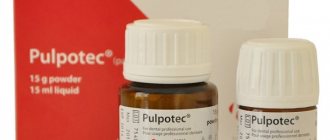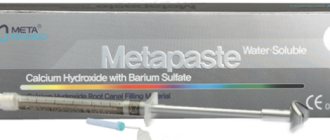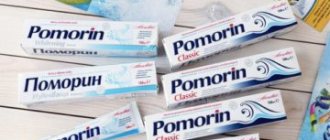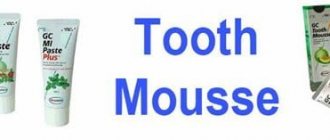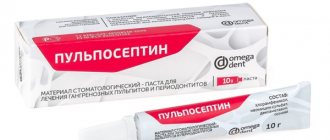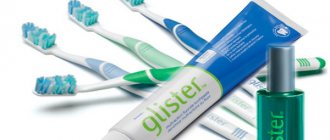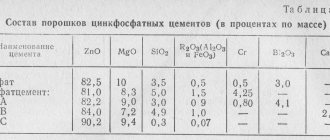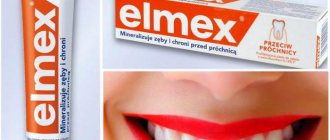Despite the constant improvement of dental treatment technologies, perforation has been and remains a problem. It occurs in nine percent of cases from the statistics of all complications during dental treatment.
However, the emergence of a drug such as Pro Root is designed to reduce the chances of this type of complications occurring and optimize the process of its treatment. Prorut is a material for direct pulp closure, as well as restoration of the internal canal if it is damaged.
Pro Root MTA in dentistry is a material used for restorative operations on the root system of damaged teeth. Easy to use, able to set even in a humid environment, easy to use Prorut will be a very profitable solution and choice for the dentist.
Designed to seal the canal between the outer and inner parts of the tooth. It is a powdery substance consisting of microscopic particles that are cemented during a chemical reaction with water.
When exposed to moisture, this product forms a gel-like paste, which then hardens into a hard barrier. Perforation itself is a consequence of an erroneously created communication channel between the outer enamel and the internal parts of the tooth.
General overview
ProRoot MTA is a mineralized trioxide aggregate, crushed to the state of a fine hydrophilic powder.
In dentistry, this material is used as a protective cement during endodontic root canal treatment of teeth.
The peculiarity of the mass is its uniform solubility and hardening when interacting with liquid.
During the dissolution process, the powder first takes on the consistency of a homogeneous gel, which, when subsequently applied to the working area, hardens, creating a mechanical barrier that prevents damage and destruction of the walls of the root canals.
Operating principle and properties
The principle of action of the drug ProRut is the mechanical coating of the walls of the root canal, which leads to its restoration and prevents further destruction.
Thus, ProRoot is capable of sealing holes between periodontal tissues and the tooth cavity if it is necessary to treat dental perforations.
During the apexification procedure, the cementing material is able to isolate the apical part of the root, sealing the canal.
During the procedure for eliminating root resorption, ProRoot covers defects on the root surface , and during retrograde filling, it prevents moisture and bacteria from penetrating under the filling.
Additionally, ProRoot can be used to provide a protective pulp cap to restore tissue vitality.
Thus, the action of ProRut is multifunctional and can be used in various ways during treatment.
Porosity analysis of MTA Fillapex endodontic sealer compared to AH Plus, Sealer 26 and Endofill
Ari da Motta
Rivaille Fidel State University of Rio de Janeiro (Brazil) Antonio Diaz Sergio Almeida National Institute of Technology Rio de Janeiro (Brazil)
Summary
. The purpose of this study was to evaluate the porosity of four endodontic sealers - MTA Fillapex, AH Plus, Sealer 26 and Endofill using a physical characterization method (mercury porosimetry analysis). The best results were shown by MTA Fillapex: the smallest porosity with the smallest diameter and average pore volume. The worst performance was demonstrated by the material Sealer 26. Endofill turned out to be slightly better. The data obtained is directly related to the material’s ability to seal perfectly.
Ary G. da Motta Jr. Rivail AS Fidel Federal University of State of Rio de Janeiro (Brazil) Antônio J. do N. Dias Sergio L. de Almeida National Institutes of Technology of Rio de Janeiro (Brazil)
Summary.
The aim of this study was to evaluate the porosity of four endodontic sealers – MTA Fillapex, AH Plus, Sealer 26 and Endofill using the method for determining the physical characteristics (mercury porosimetry analysis). The best results were achieved by the MTA Fillapex: the smallest diameter of the lowest porosity and average pore volume. Worse results showed material Sealer 26. Slightly better was Endofill. The data obtained are directly related to the ability of a material to perfect sealing.
According to the literature, approved research standards are used to evaluate the physical and chemical properties of endodontic sealers. The most famous of them are: American Dental Association (ADA) Specification 57 [1–4, 6–9, 11, 14–16, 19, 20]; ISO 6786 standard [18]; ISO 6876:2001 and American National Standards Institute (ANSI)/American Dental Association (ADA) Specification 57 [5].
To gain a more complete understanding of the physical properties of endodontic sealers, this study involves the use of a method widely used in materials science. It accurately describes the composition and structure (including defects) of any given substance [10].
Literature review
Torabinejad, Watson and Pitt Ford analyzed in vitro the sealing ability of amalgam, super EBA and MTA as a filling material for the root canal system: after staining with fluorescent rhodamine B for 24 hours, the level of dye penetration into the sections was assessed under a microscope [23]. Statistical analysis showed that MTA produced significantly less leakage than amalgam and super EBA. Torabinejad and Chivian described an experimental MTA product, which was then being developed as an alternative material in endodontics [21]. MTA cement demonstrated the absence of microleakage, biocompatibility, and the ability to stimulate cell regeneration in contact with pulp and perihilar tissues. The authors recommended the use of this material for direct pulp capping, apexification, and retrograde filling of root perforations.
Sarkar et al., conducting an in vitro assessment of the interaction of MTA cement with human root dentin, found that calcium ions released from MTA interact with phosphates, forming hydroxyapatite [17]. The sealing ability, biocompatibility and activation of dentin formation of the MTA material are the result of physicochemical reactions.
Parirokh and Torabinejad reviewed studies on the chemical composition, physical and antibacterial properties of MTA cement and found that the material has a high pH, low compressive strength and antimicrobial properties depending on the powder/water ratio [12]. MTA also affects the bioactivity of surrounding tissues. Based on available data, the authors found that MTA cement is an effective sealer and biocompatible material [22]. After analyzing articles on the disadvantages, advantages and mechanisms of action of cement in animal experiments and in clinical use, it was concluded that MTA material is suitable for filling root perforations, direct pulp capping, retrograde filling of teeth with necrotic apexes to form an apical barrier [13 ]. Disadvantages include hardening time, high price, and the potential for tooth discoloration.
Vitti and colleagues studied several properties (mixing, working and setting times, as well as flow, solubility and water absorption) of MTA Fillapex sealer (Angelus, Londrina, Brazil) in comparison with AH Plus material (Dentsply, Konstanz, Germany) [24]. The analysis of working time was carried out according to ISO 6876:2001 standards, fluidity - according to the instruction C266 of the American Society for Testing Materials. Over time (over 28 days), solubility and water absorption rates increased significantly for both materials (p<05).
Porosimetry indicators of endodontic sealers
| Siler | Porosity, % | Average pore volume, cm 3 /g | Average pore diameter, µm |
| MTA Fillapex | 0,83 | 2,121×10-3 | 1,087×10-2 |
| AH Plus | 1,09 | 7,162×10-3 | 1,410×10-2 |
| Sealer 26 | 2,49 | 1,502×10-2 | 1,239×10-2 |
| Endofill | 1,86 | 1,024×10-2 | 1,632×10-2 |
The satisfactory physical properties of MTA Fillapex have proven that it can be used as an endodontic sealer.
Purpose of the study
Analysis of the porosity of selected sealers using a physical analysis method, which opens new perspectives for the study of dental materials.
Materials and methods
All tests were carried out in the technical laboratory (LATEP) of the National Institute of Technology in Rio de Janeiro. The sealers tested were AH Plus (Dentsply), MTA Fillapex (Angelus), Sealer 26 (Denstply) and Endofill (Dentsply). The manufacturer's instructions were strictly followed. To produce the samples, molds with a diameter of 38 mm and a thickness of 6 mm were used.
The mixed sealer of each type was dipped into the molds. To obtain a smooth surface of the sample, glass for mixing was placed on top of the mold with the sealer immediately after filling it. Upon reaching the hardening time, the samples were removed from the molds and placed in an environment with a temperature of 37 °C and 100% humidity for 24 hours. The porosimetry of each sample was tested on an Autoscan-33 apparatus. A detailed process for obtaining a registration certificate can be found on the website www.minprom.ru.
Results and its discussion
The results of vaporometry are shown in the table.
In terms of overall porosity, Sealer 26 showed the worst results (Fig. 1). It is followed by Endofill and AH Plus. MTA Fillapex had the lowest porosity.
| % | cm3/g | µm |
| 0.83 1.09 2.49 1.86 | 0.0021 0.0072 0.0150 0.0102 | 0.0109 0.0141 0.0124 0.0163 |
| MTA Fillapex AH Plus Sealer 26 Endofill | MTA Fillapex AH Plus Sealer 26 Endofill | MTA Fillapex AH Plus Sealer 26 Endofill |
| Fig.1 Porosity of sealers | Fig.2 Average pore volume | Fig.3 Average pore diameter |
The same ratio of indicators was noted when analyzing the average pore volume (Fig. 2): Sealer 26 has the largest volume, MTA Fillapex has the smallest. Sealer 26 also has the largest pore diameter (Fig. 3). The sealers were then distributed as follows: Endofill, AH Plus and MTA Fillapex with the smallest diameter pores.
What was surprising was that Endofill, being a zinc oxide eugenol sealer, performed better than Sealer 26. Theoretically, the composite found in some sealers should reduce porosity, but this was not observed with Sealer 26. However, for two other sealers containing a composite - MTA Fillapex and AH Plus - this statement is quite true.
In the present study, MTA Fillapex showed the best results: lowest porosity, total volume and pore size. There is no doubt that these indicators enhance the main parameters required for sealers - impermeability and hermetic filling.
conclusions
- The chosen analysis method provided a detailed assessment of porosity and marked the beginning of a new direction in data interpretation.
- The MTA Fillapex sealer showed the best results when performing porosimetry: the smallest porosity, total pore volume and pore diameter. AH Plus material is in second place. Among composite sealers, Sealer 26 showed the worst results: many large-diameter pores.
Contact details for the authors:
Buenos Aires 93/809 – Rio de Janeiro – RJ – Brazil – ZIP code: 20070-020; [email protected] gov.br – Ari da Motta
BIBLIOGRAPHY
- Bernardes RA Evaluation of the flow rate of 3 endodontic sealers: sealer 26, AH Plus and MTA Obtura. – Oral Surg. Oral Med. Oral Pathol. Oral radiol. Endod., 2010, No. 109, p. 47–49
- Bortoluzzi EA The influence of calcium chloride on the setting time, solubility, disintegration and pH of mineral trioxide aggregate and white Portland cement with a radiopacifier. – J. Endod., 2009, v. 35, no. 4, p. 550–554.
- Camilleri J. Evaluation of selected properties of mineral trioxide aggregate sealer cement. – J. Endod., 2009, v. 35, no. 10, p. 1412–1417.
- Cunha FM Avaliação da estabilidade dimensional de alguns cimentos endodônticos nacionais contendo óxido de zinco e eugenol. – RSBO, 2008, v. 5, no. 1, p. 194–198.
- Duarte MA Influence of calcium hydroxide association on the physical properties of AH Plus. – J. Endod., 2010, v. 36, no. 6, p. 1048–1051.
- Fidel RAS Estudo in vitro sobre a solubilidade ea desintegração de alguns cimentos endodônticos que contêm hidroxido de calcio. – Rev. Odontol. Univ. São Paulo, 1994, v. 8, no. 3, p. 217–220.
- Fidel RAS Estudo in vitro da estabilidade dimensional de alguns cimentos endodônticos contendo hidroxido de calcio. – ROBRAC, 1995, v. 5, no. 16, p. 14–16.
- Fidel RAS Tempo de endurecimento de alguns cimentos endodônticos que contém hidroxido de calcio. – ROBRAC, 1995, v. 5, no. 16, p. 15–17.
- Fidel RAS Tempo de endurecimento de alguns cimentos endodônticos à base de óxido de zinco eugenol. – RSBO, 2008, v. 5, no. 2, p. 20–26.
- Mansur HS Técnicas de caracterização de materiais. – www.biomaterial.com/br/capitulo7 part 01. PDF.
- Motta AG Avaliação das Propriedades Físicas de seis Cimentos Endodônticos. – Odonto Mod., 1992, v. 19, no. 1, p. 19–24.
- Parirokh M., Torabinejad M. Mineral trioxide aggregate: a comprehensive literature review. Part III: clinical applications, drawbacks and mechanisms of action. – J. Endod., 2010, v. 36, no. 3, p. 400–413.
- Parirokh M., Torabinejad M. Mineral trioxide aggregate: a comprehensive literature review. Part I: chemical, physical, and antibacterial properties. – J. Endod., 2010, v. 36, no. 1, p. 16–27.
- Salazar R. Propriedades físicas dos cimentos endodônticos Endobalsam e N-Rickert. – Rev. Odontol. Univ. São Paulo, 1996, v. 10, no. 2, p. 121–128.
- Savioli RN Determinação da relação pó/líquido e do tempo de endurecimento de alguns cimentos endodônticos que contém óxido de zinco/eugenol. – Odontologia-USF, 1999, v. 17, p. 57–62.
- Savioli RN, Silva RG, Pécora JD Análise da radiopacidade e do pH de alguns cimentos endodônticos. – Rev. Inst. Ciênc. Saude, 2000, v. 18, no. 2, p. 111–114.
- Sarkar NK Physicochemical basis of the biological properties of Mineral Trioxide Aggregate. – J. Endod., 2005, v. 31, no. 2, p. 97-100.
- Scelza MFZ Estudo comparativo das propriedades de escoamento, solubilização e desintegração de alguns cimentos endodônticos. – Pesq. Bras. Odont. Clin. Integr., 2006, v. 6, no. 3, p. 243–247.
- Silva RG Estudo da estabilidade dimensional, solubilidade e desintegração e radiopacidade de alguns cimentos obturadores dos canais radiculares do tipo Grossman. – Rev. ABO Nac., 1994, v. 2, No. 1, r. 218–221.
- Silva RG Avaliação dos cimentos tipo Grossman: estudo do escoamento e do tempo de trabalho de alguns cimentos obturadores dos canais radiculares do tipo Grossman. – RGO, 1995, v. 43, no. 2, p. 97–100.
- Torabinejad M., Chivian N. Clinical applications of mineral trioxide aggregate. – J. Endod., 1999, v. 25, No. 3, r. 197–205.
- Torabinejad M., Parirokh M. Mineral trioxide aggregate: a comprehensive literature review – Part II: leakage and biocompatibility investigations. – J. Endod., 2010, v. 36, No. 2, r. 190–202.
- Torabinejad M., Watson TF, Pitt Ford TR Sealing ability of a mineral trioxide aggregate when used as a root end filling material. – J. Endod., 1993, v. 19, no. 12, p. 591–595.
- Vitti RP Physical Properties of MTA Fillapex sealer. – J. Endod., 2013, v. 39, No. 7, r. 915–918.
Use of MTA in general dental practice
Modern endodontics derives many benefits from the use of magnification, and especially the operating microscope. However, as a recognized expert in the field, I know that many general dentists do not have the luxury of this sophisticated technology. But dental telescopic lenses are available (photo 3), the price of which will suit all practicing dentists. Their ability to increase by 2-3 times is sufficient to perform various numerous procedures for the use of MTA cement in the root canals of teeth. The following examples illustrate techniques using MTA cement that can be implemented in general dental practice with minimal magnification.
Purpose of the drug
Indications for use are:
- filling the upper part of the tooth root;
- restoration of the integrity of the canal openings in the root and the role of a blocking element;
- during the channel update in the system during procedural treatment;
- used for direct pulp capping.
There are no restrictions or contraindications for use.
It is important to know:
- Containers with the drug Pro Root, intended for restorative operations of the root system of teeth, are prescribed to be stored in a place inaccessible to moisture, securely packaged and away from sunlight.
- The product must be applied immediately after mixing it with water to avoid dehydration during shrinkage.
- This material should be used no higher than the root of the tooth and pulp, because due to its natural characteristics it can give such an unpleasant effect as loss of color of tooth enamel.
Indications and contraindications
The paste can be used to solve the following clinical problems:
- Sealing may be indicated when performing a resection of the upper part of the root.
- Protection. If the pulp is viable, applying ProRoot material to it can speed up the resolution of the inflammatory process and maintain the functionality of the pulp chamber without additional intervention.
- Elimination of perforations of dental cavities during endodontic treatment.
- Apexification.
The product has no contraindications, except in cases of individual intolerance to the drug.
Advantages of Prorut
Possessing unique properties, the material has a sufficient number of advantageous differences from its analogues:
- ease of use;
- high biological compatibility;
- hardening in an environment with high humidity;
- no inflammation of soft tissues during use.
It also performs a number of functions, such as:
- complete pulp closure;
- seals the upper part of the tooth and root, thereby ensuring complete closure of the defective area;
- Prorut applied to the pulp promotes faster and painless healing;
- forms renewed cement cells;
- reduces bacterial contamination compared to other similar materials;
- Thanks to its unique characteristics, it ensures complete and reliable hardening even in an environment with a high moisture content - treatment and renewal of the damaged tooth root.
Resistance to edge permeability
Creates a stable barrier against the penetration of bacteria and liquids - one of the key factors in the clinical success of the material for root dentin restoration. See diagrams 1 and 2. Diagram 2 shows the percentage of dye permeability when sealing perforations without blood (white bars) and with blood (red bars).
To reduce the risk of bacterial infection, the root dentin restoration material must block the communication pathways between the root canal system and adjacent tissues. Otherwise, bacterial migration occurs. Diagram 3 indicates the minimum size of the marginal gap between the sealing material and the root walls in comparison with analogues, which allows us to judge the progress of bacterial protection technologies.
Biocompatibility. Good clinical result
ProRut MTA promotes soft tissue healing without the stage of inflammation, including the formation of new cement cells on the restored root surface. ProRuth MTA has excellent biocompatibility with soft tissues. Documented histological studies have shown that ProRut MTA provides a good clinical response and successful outcome even with retrograde obturation of the root apex. Visual proof is in x-rays (see below, Fig. 1-8)
Curing in a humid environment
Humidity is not a problem
The water-based ProRut MTA cures well in a humid environment. In a clinical situation where complete moisture removal is not always possible, ProRut MTA, due to its ability to cure in a moist environment, is ideal as an effective root restoration material.
This is interesting: How to choose a dentist?
In vitro cytotoxicity assessment of ProRoot MTA and MTA Angelus materials
Journal of Oral Science, 2008. v. 50, No. 4, r. 397–402.
Elizabeth A. Koulauzidou, Nikolaos Economides, Panagiotis Beltes Department of Preventative Dentistry, Faculty of Dentistry, Aristotle University of Thessaloniki (Greece)
George Geromihalos, Konstantinos Papazisis
Theagenion Cancer Institute (Thessaloniki, Greece)
In vitro cytotoxicity assessment ProRoot MTA and MTA Angelus
Abstract In this study, a comparative analysis was carried out in vitro of the cytotoxic effect of two MTA cements available on the dental market: ProRoot MTA and MTA Angelus, modified (for endodontic treatment) zinc oxide-eugenol cement SuperEBA, light-curing glass ionomer cement Vitrebond on rat pulp cells RPC-C2A and fetal lung human fibroblasts MRC-5. Cells were cultured under standard conditions, seeded into wells, and exposed to the test materials. Cytotoxic effects were recorded using the colorimetric tetrazolium salt reduction test (XTT method) after 24 and 72 hours and compared with those of control groups. In general, the degree of cytotoxic effects in increasing order was as follows: ProRoot MTA - MTA Angelus
Introduction Cement mineral trioxide aggregate (MTA) has been proposed for use as a material for retrograde filling [2, 35], closure of lateral and furcation perforations [27], apexification of immature apices, and obturation of the root canal system [5, 21]. The use of MTA is also effective for direct pulp capping, since the cement stimulates the formation of replacement dentin, ensuring a normal pulp healing process [20, 36]. The basis of the material is Portland cement, to which bismuth oxide has been added to improve radiopacity. There are two brands of MTA cements on the dental market: ProRoot MTA and MTA Angelus, which appeared not so long ago. A number of researchers have described the biological effects of ProRoot MTA, but few scientific articles have been devoted to the comparative assessment of the biocompatibility of ProRoot MTA and MTA Angelus [1, 29, 33]. If a tooth cavity is accidentally opened during dental treatment, a protective covering of the pulp is possible to preserve its vitality, healing and restoration of function. The choice of biological treatment method is influenced by the patient’s age, stage of root formation, size of the damage, microbial contamination, etc. In recent years, several materials have been proposed for protective pulp capping, such as zinc oxide eugenol cement, calcium hydroxide cements, traditional glass ionomer cements, and glass ionomer cements modified with composite resin, characterized by improved physical and mechanical properties [37]. Recently developed materials for coating dental pulp include MTA cements, which stimulate reparative processes in pulp tissues and the formation of a dentinal bridge [3, 26, 36]. Cell culture studies make it possible to expand knowledge about the possible toxic effects of materials and predict their impact on humans. In addition, in vitro tests are easy to perform, can be performed repeatedly, require less material input, and can be an alternative to in vivo experiments. In vitro samples usually assess the ratio of the total number of cells in contact with the test materials to the number of cells creating a stable fraction, i.e. percentage of viable cells at the end of the experiment.
Purpose of the study: To evaluate the cytotoxic effect on rat pulp cells and human embryonic pulmonary fibroblasts of two MTA cements of the ProRoot MTA and MTA Angelus brands available on the dental market, modified zinc oxide-eugenol cement SuperEBA, light-cured glass ionomer cement Vitrebond using a cell viability test based on mitochondrial dehydrogenase activity .
Materials and methods Cell lines and culture conditions Human fibroblasts MRC-5, obtained from Theagenion Tumor Tissue Bank (Thessaloniki, Greece) and rat pulp cells RPC-C2A, donated by S. Kasugai, professor of the Department of Pharmacology, Faculty of Dentistry, Tokyo Medical and Dental University (Japan). , were cultured in a single layer in T-75 flasks (Costar®Corning®), subcultured twice a week at 37˚C under 100% relative humidity in a 5% CO2 atmosphere. We used Eagle medium nutrient medium modified by Dulbecco (DMEM, Gibco, Glasgow, UK) with the addition of 10% fetal bovine serum (FBS, Gibco, Glasgow, UK), 100 mg/ml streptomycin and 100 inter. units/ml penicillin. Aged cells in the logarithmic growth phase were separated by adding 2–3 ml of 0.05% trypsin (Gibco, 1:250) and 0.02% EDTA solution and incubated for 2–5 min at 37˚C. For photometric evaluation, cells were seeded in 12-well Transwell plates (Costar-Corning, Cambridge) at an average density of 30 thousand cells per well and placed in an incubator for 24 h to achieve exponential growth.
Preparation of Test Materials The following materials were tested: white ProRoot MTA (Dentsply, York, PA, USA); white MTA Angelus (Angelus, Londrina, Brazil); SuperEBA (Bosworth Co., Skokie, IL, USA); Vitrebond (3M/ESPE, St. Paul, MS, USA). All materials were prepared according to the manufacturer's instructions and added to the bottom of the submersible wells of a 12-well Transwell plate, delimited by a membrane filter with a pore diameter of 0.4 mm. The submersible wells were then exposed to UV irradiation (180 J/cm2) and placed in wells with cell cultures and incubated for 24 or 72 hours. Six wells were prepared for each material. 12-well plates with cells without sample materials served as a control. After the exposure time, the submersible wells were removed and the number of cells was assessed using the XTT sample 2,3 bis (2-methoxy-4-nitro-5-[(sulfanylamino)carbonyl]-2H-tetrazolium hydroxide).
XTT test The XTT test was carried out in accordance with the available method descriptions [25, 30]: 500 ml of a solution (100:1) XTT (1 mg/ml) (Sigma Chemical Co, St. Louis, MO, USA) with 10 mM vitamin K3 (MEN ) were added to wells containing 2 ml of culture cells in a nutrient medium, the plates were incubated for 4 hours at a temperature of 37˚C. Optical density was assessed in an Elisa microtiter plate photometer (Anthos 2001) at a wavelength of 450 nm minus a background measurement of 620 nm. The optical density (OD) index was calculated as the difference between the average spectral absorption values of each well and the registration values (optical density of control well samples). The results were expressed in terms of survival rate, calculated using the formula: OPtest/OPcontrol) x 100%. The average optical density of control wells into which empty submersible wells were added was taken as 100%. To assess significance, nonparametric tests were used: Kruskal–Wallis and Mann–Whitney tests with Bonferroni correction (p<0.05).
Results and discussion Each experiment was carried out at least twice, the results obtained are presented in Table 1.
Table 1. Indicator of cytotoxicity of the studied materials on RPC-C2A and MRC-5 cells when exposed to 24 and 72 hours, expressed as a percentage relative to the control group
| Material | Percentage of Viable Cells | |||
| Exposure time, h | ||||
| 24 | 72 | 24 | 72 | |
| RPC - C 2 A | MRC-5 | |||
| White MTA Angelus | 92.49+5.51a* | 88.94+6.81A | 105.39±6.06a | 90.26±3.67A |
| White ProRoot MTA | 91.20±4.62a | 81.84±6.01A | 96.03±4.19a | 92.15±6.74A |
| Super EBA | 52.37±3.72b | 43.97±3.29B | 63.25±3.98b | 39.00±2.51B |
| Vitrebond | 15.06±2.88c | 10.43+0.86C | 22.06±5.12s | 19.43±6.29C |
* Average values are indicated ± standard deviation. Identical letters in columns indicate statistically insignificant error ( p >0.05). Photographs of cultured cells after exposure to the studied materials are presented in Figure 1.
Fig. 1 Photographs of cultured cells: (a) RPC-C2A in contact with white MTA Angelus, (b) RPC-C2A in contact with white ProRoot MTA, (c) MRC5 in contact with SuperEBA, (d) MRC5 in contact with Vitrebond (magnification x200)
The order of materials in order of cytotoxic effect was as follows: Vitrebond> SuperEBA>ProRoot MTA – MTA Angelus. Vitrebond cement showed the highest rate of cytotoxicity, and the activity of mitochondrial dehydrogenase in RPC-C2A and MRC-5 cells decreased significantly after 24 and 72 hours of exposure. The differences in the cytotoxic effects of Vitrebond and SuperEBA cements were statistically significant (p<0.05) in both cell lines in all periods studied. Similar results were obtained with ProRoot MTA and MTA Angelus cements. Overall, both materials showed little inhibitory effect on cell viability. Their effect was significantly lower than the effect caused by contact with Vitrebond and SuperEBA materials (p<0.05). These studies indicate the biocompatibility of MTA Angelus and ProRoot MTA cements with rat pulp cells and human embryonic pulmonary fibroblasts. To set up the experiment, cements were placed on a microporous membrane in submersible wells, which were placed in a nutrient medium on a multiwell plate. In this way, the effect of the samples on cell viability was assessed, excluding physical interaction between the test materials and target cells, and cell viability was compared in the presence of four tested cements . RPC-C2A is a clonal cell line generated from rat incisor pulp tissue by Kasugai et al. [12]. The alkaline phosphatase of RPC-C2A cells is biochemically identical to that of pulp cells and is characterized by alkaline phosphatase activity, which is a marker enzyme for cloning ability. These cells are highly proliferative and are easily cultured under standard laboratory conditions. This cell line was used in several experiments to determine cytotoxicity [14–16]. The present study also selected the human MRC-5 cell line to evaluate differences in susceptibility between the two lines. In fact, the RPC-C2A cell line was found to be more sensitive to all samples than the MRC-5 line, with the percentage of viable cells being lower across the board in RPC-C2A. Both grades of MTA cements are significantly less cytotoxic than SuperEBA and Vitrebond cements. These data confirm other studies noting the biocompatibility (bioinertness) of MTA [11, 16, 17, 23]. There were no statistically significant differences between the cytotoxicity of Angelus MTA and ProRoot MTA. Both cements have a similar chemical composition, although ProRoot MTA contains a slightly higher concentration of bismuth oxide [22, 31]. Some authors have evaluated the cytotoxic effects of two MTA cements and Portland cement on human endothelial cells [1]. No statistically significant differences were found for all materials, and the cytotoxic effect decreased with increasing exposure time. In another study in which macrophages were exposed to MTA, viability was observed in more than 97% of cells in all experiments with both ProRoot MTA and MTA Angelus cement [29]. No data on the cytotoxicity of MTA Angelus in dental pulp have been published. The present study showed that MTA Angelus has negligible cytotoxic effects on pulp cells (RPC-C2A). The results confirm the biocompatibility of MTA Angelus and are consistent with two other studies testing the effects of this cement on endothelial cells and macrophages [1, 29]. In the present experiment, the composition of white MTA was examined. It was developed for clinical use to prevent dental discoloration associated with classic gray MTA. Both white and gray MTA have similar cytotoxic effects [9] and, when covering the pulp, promote pulp healing and dentin bridge formation [19]. SuperEBA cement consists of a powder containing zinc oxide (60–75%), quartz glass or alumina (20–35%), hydrogenated resin (6%) and a liquid consisting of 63% ethoxybenzene acid (EBA) and 37% eugenol . EBA promotes the formation of a crystalline structure, which increases the strength of the material. Zincoxide-eugenol cements tend to cause inflammatory reactions, mainly due to the presence of free eugenol. The results of a number of studies indicate the cytotoxic effect of SuperEBA, which is directly related to the content of eugenol in its composition. Eugenol has been widely used as an antimicrobial and anti-inflammatory agent. However, previous in vitro and in vivo studies have demonstrated its toxic effects [4, 6, 8, 13, 10, 18]. It has been noted that eugenol inhibits cell migration, prostaglandin synthesis, tissue respiration and mitochondrial activity [4, 6, 10]. It also modifies the cell membrane [4] and stimulates neutrophils [10, 18]. Vitrebond turned out to be the most aggressive among the tested materials in all experiments conducted. Glass ionomer cements modified with composite resin have shown increased cytotoxicity, which has been confirmed by the results of several studies. Some authors have evaluated the effect of three glass ionomer cements modified with a composite resin in contact with cultured MDPC-23 cells or subcutaneous implantation in rats [32]. The materials caused a noticeable inflammatory response upon direct contact with connective tissue, and Vitrebond demonstrated the highest cytotoxic effect. The addition of leachable resin components such as 2-hydroxyethyl methacrylate (HEMA) to composite resins appears to be responsible for their cytotoxicity [28]. HEMA is a hydrophilic monomer, easily soluble in water. Vitrebond releases very large amounts of HEMA after immersion in distilled water, even after it has been photopolymerized [24]. It is capable of suppressing cell proliferation and growth [7] and can cause necrosis by inducing apoptosis in cultured fibroblasts [34].
Conclusion Under the conditions of this experiment, ProRoot MTA and MTA Angelus had similar positive effects on fibroblast mitochondrial activity. Although the results of the in vitro study cannot be directly translated to in vivo conditions, both cements can be recommended for use in clinical practice. The authors thank Professor S. Kasugai for providing the RPC-C2A cell line .
Bibliography
- De Deus G., Ximenes R., Gurgel-Filho ED et al. Cytotoxicity of MTA and Portland cement on human ECV 304 endothelial cells. – Int. Endod. J., 2005, v. 38, p. 604–609.
- Economides N., Pantelidou O., Kokkas A. et al. Short-term periradicular tissue response tomineral trioxide aggregate (MTA) as root-end filling material. – Int. Endod. J., 2003, v. 36, p. 44–48.
- Faraco EVI Jr., Holland R. Response of the pulp of dogs to capping with mineral trioxide aggregate or a calcium hydroxide cement. – Dent. Traumatol., 2001, v. 17, p. 163–166.
- Fujisawa S., Kadoma Y., Kodama Y. 'H and 13C NMR studies of the interaction of eugenol, phenol and triethleneglycol dimethacrylate with phospholipid liposomes as a model system for odontoblast membranes. – J. Dent. Res., 1988, v. 67, p. 1438–1441.
- Gaitonde P., Bishop K. Apexification with mineral trioxide aggregate: an overview of the material and technique. – Eur. J. Prosthodont. Restor. Dent., 2007, v. 15, p. 41–45.
- Gerosa R., Borin M., Menegazzi G., Puttini M. et al. In vitro evaluation of the cytotoxicity of pure eugenol. – J. Endod., 1996, v. 22, p. 532–534.
- Hanks CT, Strawn SE, Wataha JC et al. Cytotoxic effects of resin components on cultured mammalian fibroblasts. – J. Dent. Res., 1991, v. 70, p. 1450–1455.
- Ho YC, Huang FM, Chang YC Mechanisms of cytotoxicity of eugenol in human osteoblastic cells in vitro. – Int. Endod. J., 2006, v. 39, p. 389–393.
- Holland R., Souza V., Nery MJ et al. Reaction of rat connective tissue to implanted dentin tubes filled with a white mineral trioxide aggregate. – Braz. Dent. J., 2002, v. 13, p. 23–26.
- Hume WR In vitro studies of the local pharmacodynamics, pharmacology and toxicology of eugenol and zinc oxide-eugenol. – Int. Endod. J., 1988, v. 21, p. 130–134.
- Karimjee CK, Koka S, Rallis DM et al. Cellular toxicity of mineral trioxide aggregate mixed with an alternative delivery vehicle. – Oral Surg. Oral Med. Oral Pathol. Oral radiol. Endod., 2006, v. 102, p. 115–120.
- Kasugai S., Adachi M., Ogura H. Establishment and characterization of a clonal cell line (RPC-C2A) from dental pulp of the rat incisor. –Arch. Oral Biol., 1988, v. 33, p. 887–891.
- Kasugai S., Hasegawa N., Ogura H. Application of the MTT colorimetric assay to measure cytotoxic effects of phenolic compounds on established rat dental pulp cells. – J. Dent. Res., 1991, v.70, p. 127–130.
- Koulaouzidou E.A., Helvatjoglu-Antoniades M., Palaghias G. et al. Cytotoxicity evaluation of an antibacterial dentin adhesive system on established cell lines. – J. Biomed. Mater. Res. B Appl. Biomater., 2008, v. 84, p. 271–276.
- Koulaouzidou EA, Papazisis KT, Beltes P. et al. Cytotoxicity of three resin-based root canal sealers: an in vitro evaluation. – Endod. Dent. Traumatol., 1998, v. 14, p. 182–185.
- Koulaouzidou EA, Papazisis KT, Economides NA et al. Antiproliferative effect of mineral trioxide aggregate, zinc oxide-eugenol cement, and glass-ionomer cement against three fibroblastic cell lines. – J. Endod., 2005, v. 31, p. 44–46.
- Lin CP, Chen YJ, Lee YL et al. Effects pf root-end filling materials and eugenol on mitochondrial dehydrogenase activity and cytotoxicity to human periodontal ligament fibroblasts. – J. Biomed. Mater. Res. B Appl. Biomater., 2004, v. 71, p. 429–440.
- McDonald JW, Heffner JE Eugenol causes oxidant-mediated edema in isolated perfused rabbit lungs. – Am. Rev. Respira. Dis., 1991, v. 143, p. 803–809.
- Menezes R., Bramante CM, Letra A. et al. Histological evaluation of pulpotomies in dogs using two types of mineral trioxide aggregate and regular and white Portland cements as wound dressings. – Oral Surg. Oral Med. Oral Pathol. Oral radiol. Endod., 2004, v. 98, p. 376–379.
- Min KS, Park HJ, Lee SK et al. Effect of mineral trioxide aggregate on dentin bridge formation and expression of dentin sialoprotein and heme oxygenase-1 in human dental pulp. – J. Endod., 2008, v. 34, p. 666–670.
- O' Sullivan SM, Hartwell GR Obturation of a retained primary mandibular second molar using mineral trioxide aggregate: a case report. – J. Endod., 2001, v. 27, p. 703–705.
- Oliveira MG, Xavier CB, Demarco FF et al. Comparative chemical study of MTA and Portland cements. – Braz. Dent. J., 2007, v. 18, p. 3–7.
- Osorio RM, Hefti A, Vertucci FJ et al. Cytotoxicity of endodontic materials. – J. Endod., 1998, v. 24, p. 91–96.
- Palmer G., Anstice HM, Pearson GJ The effect of curing regime on the release of hydroxyethyl methacrylate (HEMA) from resin-modified glass-ionomer cements. – J. Dent., 1999, v. 27, p. 303–311.
- Paull KD, Shoemaker RH, Boyd MR et al. The synthesis of XTT: a new tetrazolium reagent that is bioreducible to a water-soluble formazan. – J. Heterocycl. Chem., 1988, v. 25, p. 911–914.
- Pitt Ford TR, Torabinejad M, Abedi HR et al. Using mineral trioxide aggregate as a pulp-capping material. – J. Am. Dent. Assoc., 1996, v. 127, p. 1491–1494.
- Pitt Ford TR, Torabinejad M, McKendry DJ et al. Use of mineral trioxide aggregate for repair of furcal perforations. – Oral Surg. Oral Med. Oral Pathol. Oral radiol. Endod., 1995, v. 79, p. 756–763.
- Ratanasathien S, Wataha JC, Hanks CT et al. Cytotoxic interactive effects of dentin bonding components on mouse fibroblasts. – J. Dent. Res., 1995, v. 74, p. 1602–1606.
- Rezende TMB, Vargas DL, Cardoso FP et al. Effect of mineral trioxide aggregate on cytokine production by peritoneal macrophages. – Int. Endod. J., 2005, v. 38, p. 896–903.
- Scudiero DA. Shoemaker RH, Paull KD et al. Evaluation of a soluble tetrazolium/formazan assay for cell growth and drug sensitivity in culture using human and other tumor cell lines. – Cancer Res., 1988, v. 48, p. 4827–4833.
- Song JS, Mante FK, Romanow WJ et al. Chemical analysis of powder and set forms of Portland cement, gray ProRoot MTA, white ProRoot MTA, and gray MTA-Angelus. – Oral Surg. Oral Med. Oral Pathol. Oral radiol. Endod., 2006, v. 102, p. 809–815.
- Souza PPC, Aranha AMF, Hebling J. et al. In vitro cytotoxicity and biocompatibility of contemporary resin-modified glass ionomer cements. – Dent. Mater., 2006, v. 22, p. 838–844.
- Souza NJA, Justo GZ, Oliveira CR et al. Cytotoxicity of materials used in perforation repair tested using the V79 fibroblast cell line and granulocyte-macrophage progenitor cells. – Int. Endod. J., 2006, v. 39, p. 40–47.
- Spagnuolo G., Mauro C., Leonardi A. et al. NF-kappaB protection against apoptosis induced by HEMA. – J. Dent. Res., 2004, v. 83, p. 837–842.
- Torabinejad M., Pitt Ford TR, McKennedy DJ et al. Histological assessment of mineral trioxide aggregate as a root-end filling in monkeys. – J. Endod., 1997, v. 23, p. 225–228.
- Tziafas D., Pantelidou O., Alvanou A. et al. The dentinogenic effect of mineral trioxide aggregate (MTA) in short-term capping experiments. – Int. Endod. J., 2002, v. 35, p. 245–254.
- Van Noort R. Introduction to dental materials. – London: Mosby Elsevier, 2007, p. 127–143.
Instructions for using ProRoot MTA:
Restoration of perforation after resorption
- After applying the Rubber Dam, clean the root canal of sawdust and half-life products, using root canal instruments and irrigating the canal with solutions containing NaOCI.
- Place a temporary filling to close access to the cavity.
- After one week of applying Rubber Dam, remove CaOH from the root canal system using root canal instruments and irrigating the canal with solutions containing NaOCI.
- Dry the canal with paper points and identify the root canal defect area.
- Perform obturation of all canals in the apical zone from the established defect area.
- Prepare the Prorut AM material according to the attached instructions.
- Using the supplied application probe, place the material into the defect area. Compact the ProRoot MTA material into the cavity using a small amalgam plunger and a cotton swab or paper points. Attention: You can condense the material using a large ultrasonic nozzle without spraying water, at medium power.
- Make sure you have placed the ProRuth MTA correctly using the x-ray. If an adequate barrier has not been created, wash the ProRut MTA material with water from the defect area and repeat the procedure.
- Place a moistened cotton swab into the cavity and seal the canal with temporary restorative material for at least 4 hours.
- After 4 hours, or during your next appointment, using Rubber Dam, inspect the ProRuth MTA material. The material must be hard. If it doesn't, wash it and reapply.
- Once the ProRoot MTA material has hardened, obturate the remaining portion of the canals. ProRuth MTA should remain as a permanent part of the root canal filling.
Repair of perforation of lateral root canals
- After applying the Rubber Dam, clean the root canal of sawdust and half-life products, using root canal instruments and irrigating the canal with solutions containing NaOCI.
- Dry the root canal system with paper points and isolate the perforation site.
- Obturate all canals located apical to the perforation.
- Prepare the Prorut AM material according to the attached instructions.
- Using the supplied application probe, place the material into the defect area. Compact the ProRoot MTA material into the cavity using a small amalgam plunger and a cotton swab or paper points.
- Make sure you have placed the ProRuth MTA correctly using the x-ray. If an adequate barrier has not been created, wash the ProRut MTA material with water from the defect area and repeat the procedure.
- Place a moistened cotton swab into the cavity and seal the canal with temporary restorative material for at least 4 hours.
- After 4 hours, or during your next appointment, using Rubber Dam, inspect the ProRuth MTA material. The material must be hard. If it doesn't, wash it and reapply.
- Once the ProRoot MTA material has hardened, obturate the remaining portion of the canals. ProRuth MTA should remain as a permanent part of the root canal filling.
Root apexification
- After applying the Rubber Dam, clean the root canal of sawdust and half-life products, using root canal instruments and irrigating the canal with solutions containing NaOCI.
- Dry the root canal system with paper points and place calcium hydroxide paste in the canal for a week to disinfect.
- After one week of applying Rubber Dam, remove CaOH from the root canal system using root canal instruments and irrigating the canal with solutions containing NaOCI. Dry the canal with paper points.
- Prepare the Prorut AM material according to the attached instructions.
- Using the supplied application probe, place the material into the defect area. Compact the ProRoot MTA material into the cavity using a small amalgam plunger and a cotton swab or paper points.
- Make sure you have placed the ProRuth MTA correctly using the x-ray. If an adequate barrier has not been created, wash the ProRut MTA material with water from the defect area and repeat the procedure.
- Place a moistened cotton swab into the cavity and seal the canal with temporary restorative material for at least 4 hours.
- After 4 hours, or during your next appointment, using Rubber Dam, inspect the ProRuth MTA material. The material must be hard. If it doesn't, wash it and reapply.
- Once the ProRoot MTA material has hardened, obturate the remaining portion of the canals. ProRuth MTA should remain as a permanent part of the root canal filling.
Root apex filling
- Provide access to the root apex and resect it using a surgical bur.
- Using an ultrasonic tip, prepare a Class I cavity to a depth of 3 to 5 mm.
- Isolate the work area. Dry the root cavity with paper points. Stop bleeding with a sealant sponge or other suitable material.
- Prepare the Prorut AM material according to the attached instructions.
- Using the supplied application probe, place the material into the defect area. Compact the ProRoot MTA material into the cavity using a small amalgam plunger and a cotton swab or paper points.
- Remove excess cement and clean the root surface with moistened gauze.
- Make sure you have placed the ProRuth MTA correctly using the x-ray. ProRuth MTA should remain as a permanent part of the root canal filling.
Pulp capping
- Using the Rubber Dam, complete the cavity preparation using burs at high speed with constant water spray.
- If caries is present, remove it using a round bur in the handpiece at low speed, or remove it using hand instruments.
- Rinse the cavity and surrounding area(s) with 2.6 – 5% NaOC1 solution. Bleeding can be controlled with a cotton swab moistened with sterile saline solution.
- Prepare the Prorut AM material according to the attached instructions.
- Using a small ball-tipped applicator or similar device, apply a small amount of ProRuth MTA to the exposed area.
- Remove excess moisture from the work area using a dampened cotton swab.
- Apply a small amount of glass ionomer light-curing liner material to cover ProRuth MTI and cure according to the manufacturer's instructions.
- Etch the remaining cavity surfaces with 34%-37% phosphoric acid gel for 15 seconds. Rinse thoroughly.
- Gently dry the cavity, leaving the dentin slightly damp but not wet. Apply adhesive. Cure according to instructions.
- Complete the restoration by applying composite material.
- At the patient's next visit, assess pulp vitality. The vitality of the pulp should be checked every 3-6 months using radiographs.
This is interesting: Classification of glass ionomer cement for filling and technique of use in dentistry
Repair of perforation of lateral root canals
- After applying the Rubber Dam, clean the root canal of sawdust and half-life products, using root canal instruments and irrigating the canal with solutions containing NaOCI.
- Dry the root canal system with paper points and isolate the perforation site.
- Obturate all canals located apical to the perforation.
- Prepare the Prorut AM material according to the attached instructions.
- Using the supplied application probe, place the material into the defect area. Compact the material into the cavity using a small amalgam plunger and a cotton swab or paper points.
- Make sure you have the correct placement using the x-ray. If an adequate barrier has not been created, wash the material away from the defect area with water and repeat the procedure.
- Place a moistened cotton swab into the cavity and seal the canal with temporary restorative material for at least 4 hours.
- After 4 hours, or during the next appointment, using Rubber Dam, inspect the material. It must be solid. If it doesn't, wash it and reapply.
- Once the ProRut has hardened, obturate the remaining portion of the canals. The material should remain as a permanent part of the root canal filling.
Instructions for mixing ProRut tooth root restoration material
Caution: ProRoot MTI does not cure as quickly as other cements. Careful mixing will make the material more flexible to use.
- Open the packet of ProRuth MTA material and place the material on the mixing pad.
- Tear off the tip of the microdose ampoule containing ProRut liquid and squeeze the contents onto a notepad next to the powder.
- Gradually mix the liquid into the cement using a ProRut MT-A mixing stick. Mix the material with the liquid for approximately 1 minute to ensure that all powder particles are moistened.
- If necessary (a spare ampoule is included or you can use distilled water), you can add 1-2 drops to mix the material to a creamy consistency. Discard any remaining liquid.
Note:
- Too little or too much liquid can reduce the strength of the cured material.
- ProRut MTA will harden within 4 hours, but working time is limited to 5 minutes. In case you need more working time, cover the mixed material with damp gauze to prevent evaporation.
Quantity:
5 x 1g. + 6 x 0.35g.
Filling the upper part of the tooth canal
The stages of filling include the following:
- Apply rubber dam, thoroughly clean the canal from sawdust and half-life products, using special tools to treat the space in the root and regularly spraying it with a liquid containing sodium hydrochloride.
- Carry out ultrasound treatment of the damaged cavity to the first class.
- Dry the area of the damaged tooth with special paper swabs and install it in the damaged area.
- Treat the channels in the nearest area against the detected defect.
- Prepare Prorut material in accordance with the instructions for use.
- Using a special dispenser-probe for placing Prorut from the supplied kit, apply Prorut to the area of the detected defect. Use a small plunger to compact the material into the damaged area, and also use paper and cotton swabs.
- Make sure that the drug has been placed correctly. An X-ray image will help you verify the correct placement of the Prorut. If it was not possible to create a strong barrier from the material, it must be washed with liquid from the damaged area and the application attempt must be repeated.
Root apex filling
- Provide access to the root apex and resect it using a surgical bur.
- Using an ultrasonic tip, prepare a Class I cavity to a depth of 3 to 5 mm.
- Isolate the work area. Dry the root cavity with paper points. Stop bleeding with a sealant sponge or other suitable material.
- Prepare the material according to the included instructions.
- Using the supplied application probe, place the material into the defect area. Compact the material into the cavity using a small amalgam plunger and a cotton swab or paper points.
- Remove excess cement and clean the root surface with moistened gauze.
- Make sure you have the correct placement using the x-ray. The material should remain as a permanent part of the root canal filling.
Restoration of resorption
The procedure includes the following steps:
- Using a rubber dam, finish the work in the cavity using burs at high speeds with constant wetting with water.
- Install the filling temporarily.
- After a week from the date of surgery, extract CaOH from the tooth and carry out the necessary treatment.
- Rinse the cavity and its surrounding area with a five percent solution of sodium hydrochloride. If bleeding occurs, it should be controlled using a cotton swab treated with a sterile solution.
- Prepare Pro Root as prescribed in the instructions.
- Taking a miniature applicator with a ball-shaped nozzle, apply a small amount of the mixture to the exposed area.
- Dry excess moisture in the work area using cotton wool.
- Mix.
- Using the supplied probe, apply the drug to the operated area.
- Use x-rays to verify correct placement.
- Fill the cavity and place a tampon on it.
- During the subsequent procedure, check the degree of hardening. If it has not completely hardened, clear the channel of it and apply it again.
How is the drug used?
When restoring a tooth after destruction of bone tissue and restoring perforation in the dental system:
- Apply a rubber dam, thoroughly clean the canal of excess objects, such as sawdust, using special tools to treat the space at the root of the tooth and regularly spraying it with a liquid containing sodium hydrochloride.
- Place a filling temporarily, blocking access to the damaged area of the tooth.
- A week later, after applying coffidam, extract CaOH from the root system, also spraying it with liquid containing sodium hydrochloride.
- Dry the area of the damaged tooth with special paper swabs and install it in the damaged area.
- Carry out obturation treatment of the root area in the closest area to the detected defect.
- Prepare the cementing material in accordance with the instructions for use.
- Using the application probe included in the kit, apply Pro Root to the area of the identified tooth defect. Use a small plunger to compact the mixture into the damaged area, and also use paper and cotton swabs.
- Make sure that the drug has been placed correctly. An X-ray image will help you verify the correct placement of the Prorut. If it was not possible to create a strong barrier from the material, it must be washed with liquid from the area of the damaged tooth and the application attempted again.
- Place a swab moistened with water into the formed canal in the tooth and fill it with materials for restoration work for a period of four hours.
- As soon as the four-hour period has passed, or during the next lesson, using a rubber dam, inspect the Prorut material. It must harden to the required state. If the composition does not harden, wash the material and reapply it.
- If the mixture has successfully hardened, treat the rest of the cavity. The drug Prorut should become a permanent filling in place of the defective area of the tooth.
You can use an ultrasonic nozzle to apply the material, turning it on at medium power. Spraying the solution in this case is not necessary.
Useful tips
It is necessary to strictly adhere to the ratio of powder and liquid specified in the instructions. Excess or lack of moisture reduces the strength of the hardened material.
To avoid dehydrogenation, ProRut should be introduced into the operating area immediately after mixing.
Curing occurs in 4 hours. The working time with the composition during standard use does not exceed 5 minutes. If more time is required, you need to cover the mixed composition with moistened gauze.
To avoid discoloration of the tooth crown , the material should only be used in root canals or at the bottom of the pulp chamber.
ProRut MTA should be stored in a dry place, hidden from direct sunlight, with the lid tightly closed.
Nuances of use
Despite the existence of general principles of technology for using the ProRut material, each individual clinical case requires a special approach to the procedure.
Let's consider the main nuances of work when performing various tasks.
Perforation restoration
When performing a perforation repair procedure, it is important to ensure that the installed material is positioned adequately and that it hardens after installation.
During treatment, several control images using x-rays may be required, as well as reinstallation of poorly “adhered” material.
A detailed description of the procedure for restoring perforation can be found in the article above.
Pulp capping
There are the following features of the pulp capping procedure:
- A light-curing material is applied on top of the applied ProRut material, which is illuminated in accordance with the technology proposed by the manufacturer.
- Dentin cavities are etched for 15 seconds using phosphoric acid. After pickling, everything is thoroughly washed.
- Then, everything is dried so that the dentin remains slightly damp, but not excessively. An adhesive is applied to the dental tissue and illuminated in accordance with the technology.
- The procedure ends with the application of a composite material.
After the procedure is completed, the patient is scheduled for another appointment, during which the vitality of the pulp is assessed.
Root apexification
- Rubber dam application.
- Treatment of the canal with boron, cleaning of sawdust and decay products, disinfection with NaOCI, drying with paper points.
- Placement of a disinfectant composition (calcium hydroxide) into the canal.
- Weekly break.
- Extraction from the canal (Ca(OH)2, disinfection of the cavity with NaOCI, drying with paper points.
- Mixing ProRut.
- Injection of material into the defect area, compaction using a plunger. (Condensation of the material can also be done using an ultrasonic nozzle).
- Verification using radiography of the correct application of ProRut.
- Place a moistened cotton swab on the ProRoot and place a temporary filling on top of it.
- Control of material hardness (check no earlier than after 4 hours).
- Obturation of the free part of the canal.
This is interesting: Figure correction
Apical closure in one visit
There are many literature sources describing the technique of apexification using Ca(OH)2. Calcium hydroxide can be used to induce apexification in unformed apices or in apices destroyed by pathological processes. Using Ca(OH)2 is time consuming. In some cases, treatment takes up to two years, including repeated replacements of this material in the root canals. If the patient does not come to one of the follow-up visits, the method may fail.
MTA cement has been successfully used for apexification in one visit. The tooth is restored almost immediately. This is an excellent technique, suitable for both children and adults, as the following case demonstrates.
An adult girl aged 18 years had previously undergone root canal treatment on a central incisor. There was swelling and tenderness on the vestibular side. The crown was going to be replaced with a new one, but an x-ray showed that the filling material in the large-diameter root canal was undercondensed and the apex was wide open. The root canal was accessed. Gutta-percha was removed by Hedstrom files. After determining the length of the canal with X-ray confirmation, it was found that the apical region has a diameter of more than 120 according to the ISO standard - this is too large a diameter for controlled gutta-percha obturation.
The root canal is generously irrigated with sodium hypochlorite solution and minimally shaped to give the canal space a conical shape. Due to time constraints, no other work was performed at the first visit. The canal was filled with a preparation based on calcium hydroxide Ultracal, a cotton ball and a temporary filling made of IRM material were applied.
A week later, the canal was reopened (pain and vestibular swelling had disappeared) and the calcium hydroxide preparation was removed. To create a plug from MTA cement, we used a straight large diameter (diameter 1.20 mm) transfer tool from the MAP kit. Particular attention was paid to the position of the transporter in the apical region. During the insertion of the approximately 2 mm thick MTA plug, the tip of the vector was positioned at a distance of 1–2 mm from the root exit. Two or three portions of MTA introduced this time can be condensed using Dovgen pluggers of appropriate sizes. It was observed that the last portion did not reach the radiographic length of the root by approximately 1.5 mm. A brief exposure to ultrasound (5 sec) on the surface of the MTA cement using the ProUltra No5 ultrasonic attachment (Dentsply) displaced the material by the missing millimeters and led to its perfect position at the root.
A wet paper point was placed in the canal, the access cavity was closed with a cotton ball and a temporary filling made of IRM cement. The patient was asked to return later in the day (after four or more hours had passed) to ensure the hardness of the MTA cement. As expected, he became hard as a rock. The remaining part of the canal above the MTA cement was filled with thermoplastic gutta-percha using the Obtura system (Spartan Obtura).
Three months later, the tooth was asymptomatic and the periapical lesion had disappeared. Now you can install a new crown.
Root apex filling
- Provide access to the apical zone of the root using suitable burs.
- Rubber dam application.
- Treatment of the canal using an ultrasonic nozzle.
- Dry the canal with paper points; if there is blood in the canal, it should be removed with a sponge.
- Mixing ProRut.
- Introduce material into the apical zone using the included probe.
- Compact the ProRut with a plunger, remove excess material, clean the channel surface with damp gauze.
- Checking the correct filling of the root apex with material using radiography.
Creating a Pulp Barrier
To create a reliable pulp barrier, you must adhere to the following rules:
- Using a rubber dam, finish the work in the tooth cavity using burs at high speeds with continuous wetting with water.
- If caries has been detected, work should be carried out to remove it using a round bur at low speeds, or remove it manually using appropriate tools.
- Rinse the cavity and its surrounding area with a five percent solution of sodium hydrochloride. If bleeding occurs, it should be controlled using a cotton swab treated with a sterile solution.
- Prepare Prorut in accordance with the instructions in the instructions.
- Taking a miniature applicator with a ball-shaped nozzle, apply a small amount of Prorut to the exposed area.
- Dry excess moisture in the work area using cotton wool.
- Apply cushioning material, creating a coating for the drug, and carry out polymerization in accordance with the instructions in the instructions for it.
- Etch the remaining surface of the treated area with a 37% phosphoric acid solution for fifteen seconds. Then carefully treat the etching area.
- Drain the cavity as delicately and carefully as possible; the dentin should remain slightly moist. Then carry out polymerization.
- Restoration work is completed by applying a Spectrum-type composite, or using any analogue suitable for the parameters.
- At the patient's next visit, the condition of the pulp is assessed. Regular checks of her condition and vitality should be carried out every three months, monitoring her condition using data obtained from x-rays.
Creating a Pulp Barrier
To create a reliable pulp barrier, you must adhere to the following rules:
- Using a rubber dam, finish the work in the tooth cavity using burs at high speeds with continuous wetting with water.
- If caries has been detected, work should be carried out to remove it using a round bur at low speeds, or remove it manually using appropriate tools.
- Rinse the cavity and its surrounding area with a five percent solution of sodium hydrochloride. If bleeding occurs, it should be controlled using a cotton swab treated with a sterile solution.
- Prepare Prorut in accordance with the instructions in the instructions.
- Taking a miniature applicator with a ball-shaped nozzle, apply a small amount of Prorut to the exposed area.
- Dry excess moisture in the work area using cotton wool.
- Apply cushioning material, creating a coating for the drug, and carry out polymerization in accordance with the instructions in the instructions for it.
- Etch the remaining surface of the treated area with a 37% phosphoric acid solution for fifteen seconds. Then carefully treat the etching area.
- Drain the cavity as delicately and carefully as possible; the dentin should remain slightly moist. Then carry out polymerization.
- Restoration work is completed by applying a Spectrum-type composite, or using any analogue suitable for the parameters.
- At the patient's next visit, the condition of the pulp is assessed. Regular checks of her condition and vitality should be carried out every three months, monitoring her condition using data obtained from x-rays.
